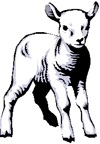|
|
|




|
Passover
|
|
Jewish Calendar |
Nisan 14 |
|
Gregorian Calendar |
March/April |
|
Spring or Fall |
Spring Feast |
|
Scripture |
Leviticus 23:5
Matthew 26:2 |
|
Significance |
Passover speaks of redemption; Christ the Passover Lamb was slain at
Calvary for the sins of the world. |
Introduction
Passover is the first of the seven annual festivals celebrated by the Jewish people and
is considered to be Israel's foundational feast upon which the other six feasts that
follow simply build upon. Passover, a feast which commences Israel's religious year,
is often referred to as the Feast of Unleavened Bread
because only unleavened bread was eaten during the seven days immediately following Passover.
While the Jewish people have celebrated Passover annually since the time
of Moses, in reality, there was only one Passover. It occurred almost 3500 years
ago down in Egypt. It was there, at that time, that a lamb was sacrificed, and the
blood was applied to each doorpost and lintel. When done in faith and in obedience to
God's command, that home was "passed over" by the death angel and the firstborn was spared.
All subsequent observances over the centuries were memorials of that one and only
first Passover.
Historical Meaning
For more than 400 years, the Jewish people had lived in Egypt (Exodus 12:40). However, the time
had come for God to fulfill His covenant with Abraham and bring them back to their
homeland as He had promised (Genesis 46:3-4; 50:24). Therefore, God raised up one man to deliver
His chosen people; this man's name was Moses. One day God spoke to Moses in a desert through a burning
bush; this bush burned but was not consumed (Exodus 3:2). It was there that God revealed to Moses
that He had seen the affliction of His people down in Egypt, had heard their cry for help, and had known their sorrows.
Now, He was coming down to deliver them out of Egyptian
bondage and bring them into the promised land (Exodus 3:7-8).
In Exodus 11, God detailed, through
His servant Moses, the tenth and final judgment plague which would befall the Egyptians
and their so-called "gods" or "deities."
At midnight, the Lord would pass through the land of Egypt and kill
the firstborn of each home where a lamb was not slain and where
blood was not applied to the doorpost and lintel.
The effects of this tenth and final plague would even reach the palace. Since the
pharaoh of Egypt was worshipped as a god, a god's son would die. Some scholars
believe that King Tut's mysterious death was due to this tenth plague.
With this final climatic plague, God would dramatically set His people free
from the bondage of Egypt.
In Exodus 12, God outlined in detail the steps to be taken by those who trusted
in Him so that they, unlike Pharaoh and the Egyptians, would not be struck
down by the final plague. On the tenth day of the Hebrew month of Nisan, they were to select a year-old
lamb without blemish or spot out from the flock and keep it until the fourteenth day of the month (Exodus 12:3).
During this time frame, each family would
become personally attached to their lamb so it would no longer be just an ordinary lamb
(Exodus 12:3) but their very own pet (Exodus 12:5). This would deeply impress
upon them the costly nature of the sacrifice; an innocent lamb was to die in their place.
On the evening of the fourteenth day of the first month, as the sun was setting, the lambs were to be
publicly killed by "the whole assembly" and then subsequently eaten (Deuteronomy 16:7);
none of the animal was to be left over on the following morning (Exodus 34:25).
Although collectively, everyone was responsible for the death of the lambs, each family
was to individually apply the blood of their lamb to the doorposts of their own home as a visible sign of their
faith in the Lord (Exodus 12:13). At that moment, the innocent lamb became their
substitute making it possible for the Lord's judgment to "pass over" them. Therefore,
the Lord instituted Passover as "a night to be much observed unto the Lord for bringing
them out from the land of Egypt" (Exodus 12:42).
The Service
God commanded that Passover be observed as a memorial forever (Exodus 12:14). He also
declared that it was to be kept by a service (Exodus 12:25). This service was to
incorporate the lamb, the matzah (unleavened bread), and bitter herbs as well as raise questions in the minds
of children so that the Exodus story could be rehearsed from generation to generation (Exodus 12:26-27).
The Lord, however, did not detail the order of the service; He only mentioned that it was to be
kept.
As recorded in Exodus 12:8, God required three symbolic foods to be eaten that Passover
night: the lamb, matzah (unleavened bread), and bitter herbs (called "maror" in Hebrew).
The sacrifice was to be a young lamb, depicting innocence. It was to be roasted
with fire portraying the judgment that would befall it instead of their own firstborn. Matzah
was to be eaten symbolizing the purity of the sacrifice since leaven, with its souring
characteristic, was often a symbol of sin (I Corinthians 5:6-8). In addition,
bitter herbs were to be eaten as a reminder of the suffering of the lamb.
Several centuries before Christ, a somewhat traditionalized Passover service began to
emerge. The ritual Passover service was called the Seder from the Hebrew word
meaning "order." It prescribed the traditional order of the Scripture readings, prayers,
symbolic foods, and hymns in the Passover service. The basic order of the Passover Seder
today remains much as it was during the time of Christ even though the service continued
to be embellished with more song and traditions up through the Middle Ages.
The Importance
Several important facts must be understood concerning the holiday feast of Passover.
-
First of all, there was only one Passover in the history of mankind; this
even occurred when the Lord passed through the land of Egypt executing judgment.
Every observance since then has been a memorial commemorating that occasion (Exodus 13:3).
-
Secondly, Passover is an ancient feast, one that spans some thirty-five centuries of human
existence. This holiday forms the primary background for understanding the events
of the Upper Room, the symbolism of the Lord's Table (Communion), and the meaning of the Messiah's
(Jesus) death.
-
Thirdly, Passover holds great distinction among the religious feasts of the world. Passover is
the oldest continually observed feast in existence today, celebrated for some 3,500
years. Even today, more Jewish people keep Passover than any other high holy
day. It is a strong, cohesive force within the fabric of Jewish community and culture.
-
Finally, Jesus (Yeshua) was crucified during the Passover event. He and His disciples ate
a Passover meal together on the eve of His death. During this meal Jesus said, "This
is my body," and "this cup is the new testament in my blood" (Luke 22:7, 19-20).
All of those lambs sacrificed down in Egypt (one per household) pointed to
the one true Lamb of God who takes away the sin of the world (John 1:29). Writing
to the Corinthians, the apostle Peter noted for all of time, "Christ, our
passover (Lamb), is sacrificed for us" (I Corinthians 5:7).
|
|



 Back to the "Christ-Centered Mall" Back to the "Christ-Centered Mall"

This teaching was written by David Holt Boshart, Jr.
All scans done by Christ-Centered Mall, Inc. are prohibited from being copied.
All applicable copyright© laws apply and are reserved by Christ-Centered Mall.
Web pages copyright© 1998-2006. |
|

 Back to the "Christ-Centered Mall"
Back to the "Christ-Centered Mall"